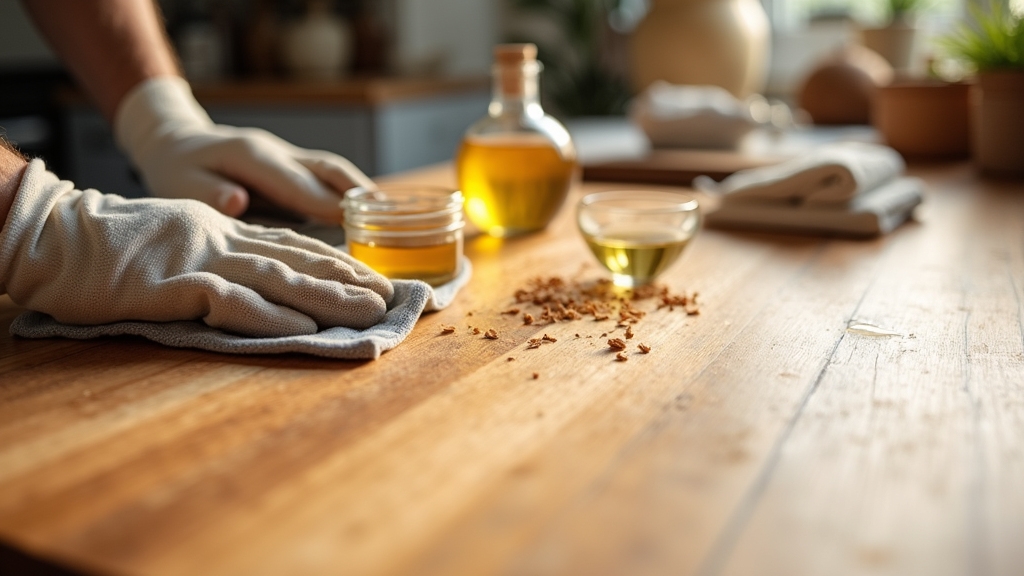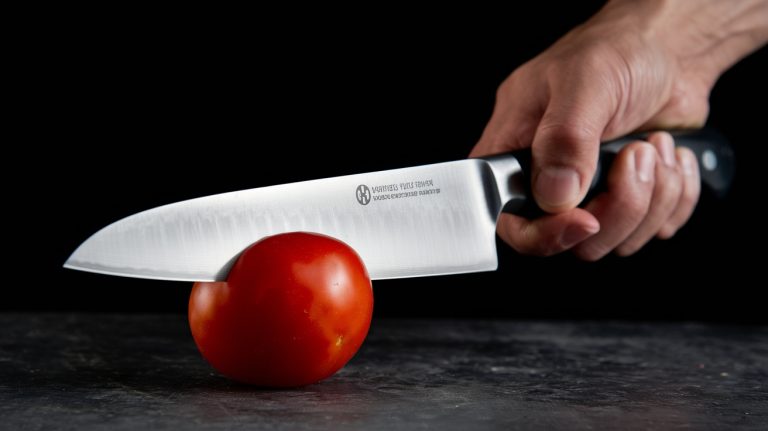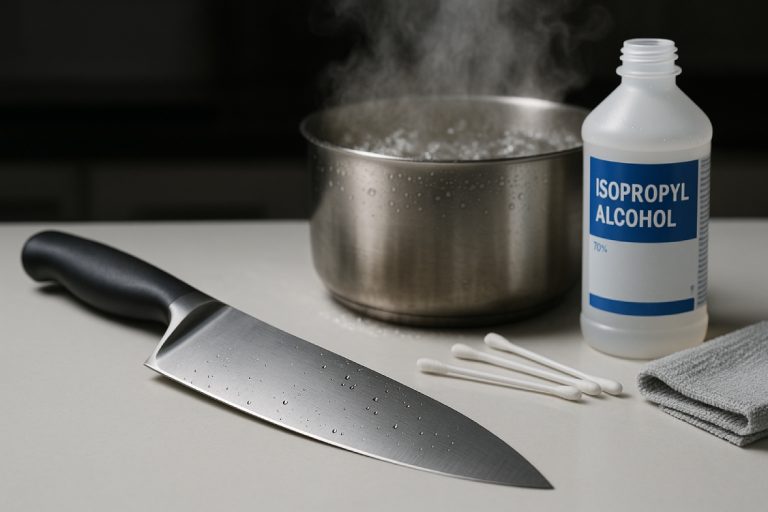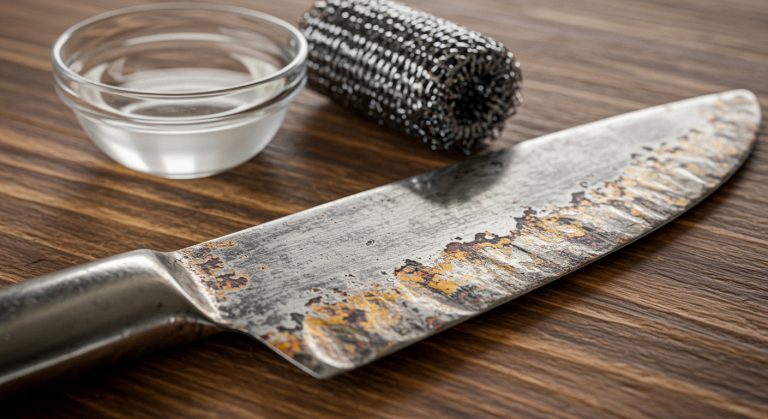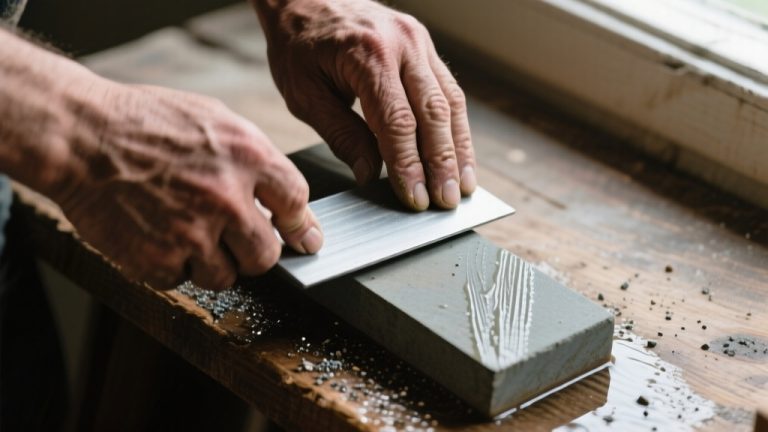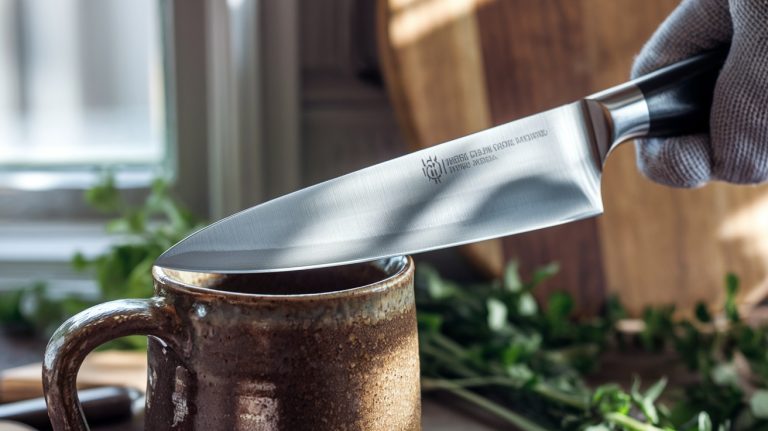How to Care for a Butcher Block Countertop: Simple Steps
To care for your butcher block countertop, clean it daily with a damp cloth and mild soap.
Then dry immediately to prevent swelling. Remove stains gently using baking soda or lemon and salt, and avoid harsh chemicals.
Regularly apply food-grade mineral oil to keep the wood moisturized and protected. For deeper restoration, sanding and re-oiling may be necessary.
If you want to guarantee durability and hygiene, understanding detailed maintenance and repair techniques will prove essential.
Key Takeaways
- Clean daily with a damp cloth and mild soap, then dry immediately to prevent water damage and staining.
- Remove stains promptly using lemon and salt or baking soda paste, scrubbing gently along the wood grain.
- Apply food-grade mineral oil regularly, daily during the first week, then monthly to maintain moisture and prevent cracking.
- Avoid harsh chemicals, abrasive tools, and placing hot items directly on the surface to protect the finish.
- Sand and refinish with fine-grit sandpaper and mineral oil periodically for deep restoration and to extend lifespan.
Daily Cleaning and Maintenance
Although butcher block countertops are durable, you should clean them daily with a damp cloth or sponge to remove loose debris and spills promptly.
For light grease or dirt, add mild dish soap to water, then rinse thoroughly with clean water to avoid residue buildup. Regular cleaning is essential to maintain the surface and prevent corrosion resistance issues typical of metal surfaces.
Use a soft-bristled brush for gentle scrubbing aligned with the wood grain when necessary. Routine cleaning with soap and water helps maintain the wood’s condition.
After cleaning, dry the surface immediately with a microfiber or lint-free cloth to prevent water absorption and potential swelling.
To lift stuck-on particles without damage, use a dough or plastic scraper; apply a razor blade carefully for very light residue.
Avoid harsh chemicals, metal scrapers, or abrasive pads, as these can degrade the finish and wood fibers, compromising the butcher block’s integrity and longevity.
Effective Stain Removal Techniques
Keeping your butcher block countertop clean on a daily basis helps prevent stains from setting. When spills do leave marks, timely and appropriate stain removal is necessary to maintain the surface’s appearance and integrity.
Start by wiping spills immediately with a damp, soapy sponge. Then blot dry to avoid moisture penetration. Avoid standing water as wood is porous and susceptible to bacterial growth. Using tools with safety features can also help protect your hands during cleaning.
For mild stains, apply a lemon and salt slurry, scrubbing gently in circular motions to leverage acidity and abrasion without damaging the wood.
Tougher stains respond well to a baking soda paste, applied and scrubbed along the grain before thorough drying.
For severe, deeply set stains, light sanding with fine-grit paper removes the affected layer, followed by reconditioning.
Always dry surfaces promptly to prevent warping or swelling.
- Immediate wiping with mild soap and drying
- Lemon and salt slurry for mild stains
- Baking soda paste or fine sanding for stubborn marks
Proper Oiling and Moisturizing Practices
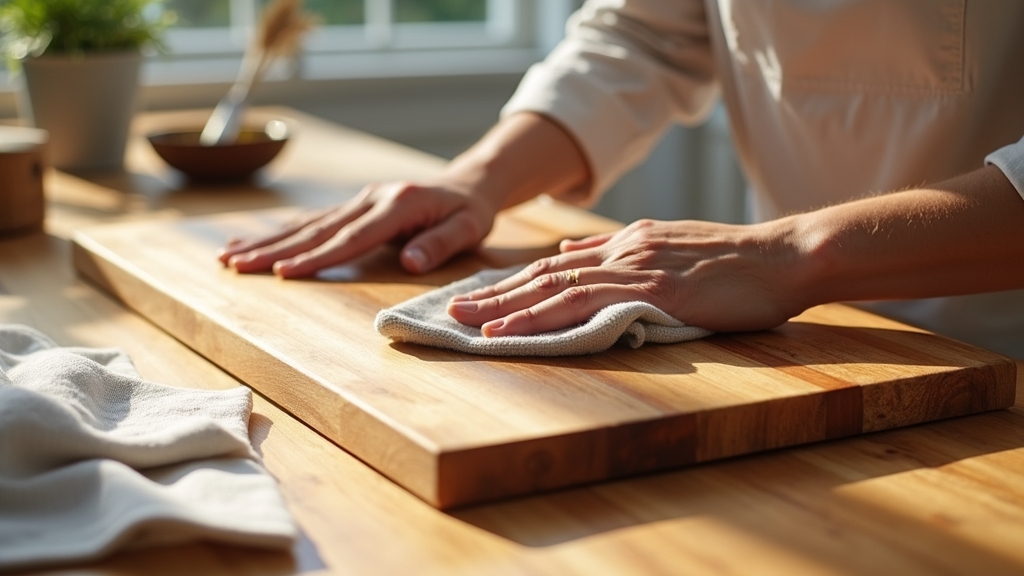
When you maintain your butcher block countertop, proper oiling and moisturizing play critical roles in preserving its durability and appearance.
Use food-grade mineral oil for daily application during the first week, then monthly for the first year. Adjust frequency based on usage and visible dryness. Food-safe mineral oil is essential for preparing food on butcher block countertops to keep the wood in top condition. It is important to inspect surfaces regularly to ensure the oil has penetrated evenly and no areas are left dry.
Combine mineral oil with organic beeswax for enhanced protection. Avoid oils like coconut or olive that can become rancid.
For moisturizing, clean with warm water and mild soap without saturating the wood, then dry thoroughly to prevent moisture damage.
Employ dough scrapers and lint-free cloths for debris and oil application. Regularly inspect for dryness or damage and reapply oil as needed to prevent bacterial infiltration and wood deterioration.
Deep Restoration and Refinishing Methods
Before you begin deep restoration of your butcher block countertop, thoroughly cleaning and preparing the surface is essential to guarantee effective refinishing. Remove all items, scrub with mild soap and water along the grain, disinfect with diluted bleach or vinegar, and remove stuck debris gently.
Use a nylon scrub brush and sponge for effective cleaning to avoid damaging the wood grain. Ensuring the board is completely dry after cleaning is crucial to prevent moisture interference during refinishing.
Sand the surface starting with 180-grit coarse paper to eliminate old finishes and scratches, progressing to 320-grit for smoothness. Address cracks or gouges by filling them with food-safe wood fillers or epoxy, allow drying, then sand flush. For small cracks, melted wax can also be used as a filler before sanding. Sand top, edges, and underside for balanced absorption to promote even protection.
Apply thin coats of mineral or tung oil after sanding. Buff the cured surface to enhance smoothness and sheen. This precise method restores durability and prepares your butcher block for safe, lasting use, providing long-lasting durability with proper sealing and maintenance.
Tips for Preventing Damage and Extending Lifespan
Although butcher block countertops are durable, preventing damage requires consistent care and attention to specific maintenance practices. You should regularly apply food-safe oil to hydrate the wood, avoid placing hot items directly on the surface, and clean spills immediately to prevent stains and water damage.
Applying a barrier with food-grade mineral oil helps prevent water absorption and loss, which protects the wood and enhances its patina. Incorporating a protective finish like mineral oil can significantly improve moisture resistance. Monitoring dryness and resealing when necessary ensures longevity.
| Prevention Focus | Key Actions |
|---|---|
| Water Damage | Dry spills instantly; reseal regularly |
| Heat Damage | Use trivets; avoid direct contact with hotware |
| Lifespan Extension | Apply oil routinely; avoid over-sanding |
Frequently Asked Questions
Can I Use My Butcher Block Countertop as a Cutting Surface for Raw Meat?
You can use your butcher block countertop as a cutting surface for raw meat, but it requires strict maintenance.
Always seal the wood regularly with food-safe oils to prevent juice absorption.
Designate a specific area or use separate cutting boards to minimize contamination.
Clean and sanitize immediately after contact with hot, soapy water and drying.
Avoid letting juices sit, and sand out deep scratches to maintain hygiene and prevent bacterial growth effectively.
How Do I Know When It’s Time to Sand and Refinish My Butcher Block?
If your butcher block looks like a battle-scarred relic with scratches, stains that laugh at your cleaning, or watermarks like abstract art, it’s begging for a sanding and refinish.
Run your hand over rough patches or splinters; roughness screams for smoothing.
Cracks, peeling finish, or moldy dark spots? Don’t wait.
When oil soaks in like a sponge and odors linger despite scrubbing, it’s time to strip, sand, and restore that wood’s dignity.
What Type of Oil Is Safest for Food Preparation Surfaces?
You’ll want to use food-grade mineral oil or white mineral oil for safety on food prep surfaces. They’re FDA-approved, non-toxic, colorless, and odorless.
Pure tung oil is also safe once fully cured, offering durability. Beeswax blends with mineral oil seal and protect effectively.
Avoid cooking oils like olive or vegetable, as they can spoil. Always confirm oils are labeled food-safe to prevent contamination and maintain a hygienic surface.
Can I Use a Dishwasher to Clean My Butcher Block Countertop?
Think of your butcher block like a delicate violin. Exposing it to a dishwasher’s heat and moisture is like soaking the wood in a rainstorm.
You shouldn’t use a dishwasher to clean your butcher block countertop. The intense heat and water can warp and soften the wood, while harsh detergents damage its finish.
Instead, clean manually with mild soap and warm water. Then dry thoroughly to maintain its integrity and longevity.
How Do I Fix Small Cracks or Splits in My Butcher Block?
To fix small cracks in your butcher block, first clean the area thoroughly with rubbing alcohol and let it dry.
Lightly sand the crack with medium-grit sandpaper, following the wood grain.
Fill the crack using wood putty or a mixture of wood glue and sawdust, applying with a putty knife for full penetration.
Remove excess filler before it dries.
After drying, sand smooth and reseal with food-safe mineral oil or beeswax.
Transform Routine Cleaning into Lasting Protection
You’ll find that daily cleaning keeps your butcher block fresh, while deep restoration revives its worn surface. Proper oiling locks in moisture, preventing cracks, yet neglect invites damage and shortens lifespan.
Stain removal requires precision, contrasting with the simple act of wiping down. By balancing routine care with occasional refinishing, you’ll maintain both beauty and durability.
This careful maintenance guarantees your butcher block remains a reliable, long-lasting centerpiece in your kitchen.

